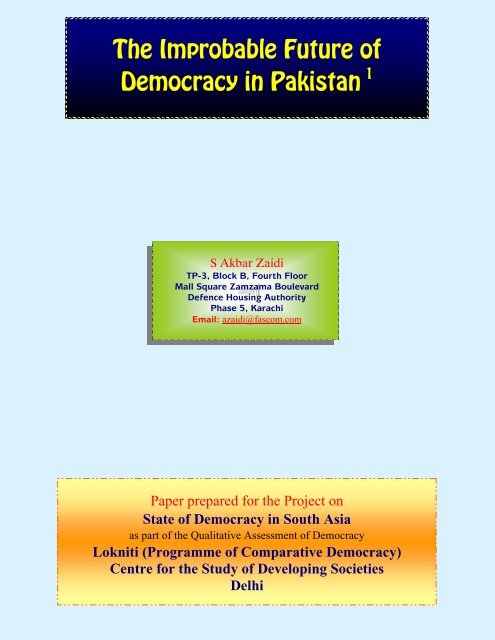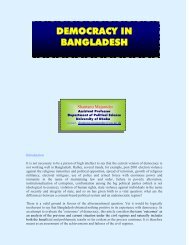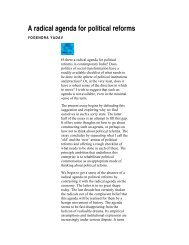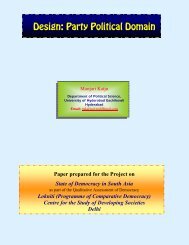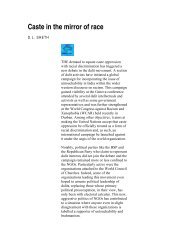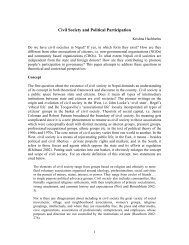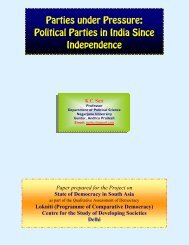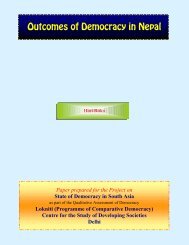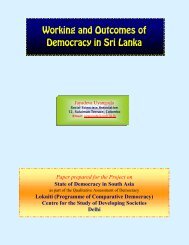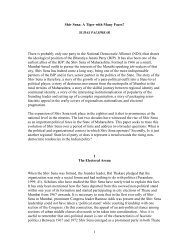The Improbable Future of Democracy in Pakistan - Democracy Asia
The Improbable Future of Democracy in Pakistan - Democracy Asia
The Improbable Future of Democracy in Pakistan - Democracy Asia
You also want an ePaper? Increase the reach of your titles
YUMPU automatically turns print PDFs into web optimized ePapers that Google loves.
different times reflected the aspirations <strong>of</strong> all classes.In the beg<strong>in</strong>n<strong>in</strong>g, lead<strong>in</strong>g up to the general elections <strong>of</strong> 1970, and <strong>in</strong> the first two years <strong>of</strong> his rule,organized labour, peasants, middle farmers, the urban and rural middle class, and the educatedpr<strong>of</strong>essional urban middle class all supported Bhutto’s left-lean<strong>in</strong>g economic policies. <strong>The</strong> bureaucracyand <strong>in</strong>dustrialists were the key ‘enemies’ <strong>of</strong> the new social programme <strong>of</strong> the early 1970s, while thediscredited military, although not such a direct target as the other two, was marg<strong>in</strong>alized andsidel<strong>in</strong>ed. <strong>The</strong> large landown<strong>in</strong>g lobby, too, suffered the anger <strong>of</strong> the establishment, and the 1972 landreforms were meant to break their (dormant though aspir<strong>in</strong>g) political ambitions.However, the political settlement that emerged <strong>in</strong> the early years <strong>of</strong> the Bhutto regime soon changed,and the same classes which had been targeted, rega<strong>in</strong>ed their prom<strong>in</strong>ence. <strong>The</strong> 1972 land reforms didnot really break the hold <strong>of</strong> the large landowners and were more a showpiece political ploy, despitethe avowed political programme <strong>of</strong> the <strong>Pakistan</strong> People’s Party. Hav<strong>in</strong>g abused and <strong>in</strong>sulted the‘feudal’ landowners, Bhutto brought them back <strong>in</strong>to his fold. <strong>The</strong> educated left-lean<strong>in</strong>g urban middleclass was <strong>in</strong> disfavour <strong>in</strong> the Bhutto ranks, although Bhutto persisted with much <strong>of</strong> his social reformagenda. With massive nationalization, the bureaucracy was back <strong>in</strong> favour and began to consolidate itshold over the means <strong>of</strong> production. <strong>The</strong> military, too, found favour when Bhutto had to quell the armedrebellion <strong>in</strong> Balochistan. Hence, the political groups which had been discredited <strong>in</strong> the early Bhuttoperiod re-emerged as Bhutto needed their assistance, and were ready to take revenge for the showtrials <strong>of</strong> the earlier period.<strong>The</strong> <strong>in</strong>dustrialists, however, were never welcomed back. <strong>The</strong> nationalization <strong>of</strong> banks broke the criticall<strong>in</strong>k between f<strong>in</strong>ance and <strong>in</strong>dustrial capital, and much <strong>of</strong> the capital held by <strong>in</strong>dustrialists fledoverseas. While this class <strong>of</strong> <strong>in</strong>dustrialist was discrim<strong>in</strong>ated aga<strong>in</strong>st and hounded out, not just from theeconomy, but also from the country, Bhutto’s reforms helped to consolidate the small-scalemanufactur<strong>in</strong>g process started by the Green Revolution. Small-scale <strong>in</strong>dustry and the <strong>in</strong>formal sectorbecame the backbone <strong>of</strong> <strong>in</strong>dustry, replac<strong>in</strong>g the twenty-two families <strong>of</strong> Ayub’s era. This urban middleclass, which consolidated itself under Bhutto, eventually allied itself with other sections <strong>of</strong> the urbanmiddle class, backed by the bureaucracy and probably the military, and was <strong>in</strong>strumental <strong>in</strong> remov<strong>in</strong>gBhutto <strong>in</strong> 1977. Thus, the beneficiaries <strong>of</strong> Bhutto’s economic programme led the movement to removehim from power, just as the results <strong>of</strong> Ayub Khan’s programme caused his (Ayub’s) downfall.Hence, between 1947 and 1977 the follow<strong>in</strong>g picture <strong>of</strong> <strong>Pakistan</strong>’s political economy emerges. Largescaleeconomic development had taken place, <strong>in</strong> both urban and rural areas, giv<strong>in</strong>g rise to a middleclass that was still young and economically prosperous, but was essentially non-existent <strong>in</strong> politicalterms. Industrialists, hav<strong>in</strong>g made great <strong>in</strong>roads and extraord<strong>in</strong>ary economic ga<strong>in</strong>s <strong>in</strong> the first twentyfiveyears, were nowhere on the scene, even <strong>in</strong> economic terms, <strong>in</strong> 1970; many had lost their fortunes,while others had fled the country. <strong>The</strong> ‘feudals’ had <strong>in</strong>creas<strong>in</strong>gly been los<strong>in</strong>g economic power asmechanization took hold <strong>in</strong> agriculture, and as capitalist agriculture began to dom<strong>in</strong>ate production.Those large landowners who could see the changes tak<strong>in</strong>g place and were able to adapt managed tosurvive f<strong>in</strong>ancially, while others were forced to sell or rent out their land to the aggressive middlefarmers. As a political entity, however, especially under a democratic order, the large landowners didcontrol a number <strong>of</strong> seats, particularly <strong>in</strong> S<strong>in</strong>dh, southern Punjab and parts <strong>of</strong> Balochistan, where triballords held power. <strong>The</strong> civilian and military bureaucrats were the only political group<strong>in</strong>g which, despitea small period <strong>in</strong> quarant<strong>in</strong>e, cont<strong>in</strong>ued their <strong>in</strong>fluence on the political structure <strong>of</strong> the country. <strong>The</strong>heyday <strong>of</strong> the civil and military bureaucracy, however, was still to come.II.4 A Military State and the Middle Classes: 1977–88<strong>The</strong> takeover by General Zia ul Haq crystallized the hegemony <strong>of</strong> the civil and military bureaucracy,not just on the political map <strong>of</strong> <strong>Pakistan</strong>, where they had existed previously, but also, for the firsttime, <strong>in</strong> the generation and distribution <strong>of</strong> economic resources and wealth. With political andadm<strong>in</strong>istrative roles and <strong>in</strong>terests, the civil and military bureaucracy emerged as a key and entrenchedentity <strong>in</strong> the economy. It established and consolidated its role <strong>in</strong> economics and politics throughout theZia period, go<strong>in</strong>g from strength to strength.Despite the pro-private sector penchant <strong>of</strong> Zia’s regime, much <strong>of</strong> the <strong>in</strong>dustry nationalized underBhutto was not returned to the orig<strong>in</strong>al owners because it permitted the bureaucracy to cont<strong>in</strong>ue toplay an important role <strong>in</strong> the economy. <strong>The</strong> bureaucracy emerged as a critical ally for Zia, and he hadno need to underm<strong>in</strong>e their role by distanc<strong>in</strong>g them from key areas <strong>of</strong> economic control and power.<strong>The</strong> role <strong>of</strong> the military also changed compared to when it was first <strong>in</strong> power under Ayub. Earlier, themilitary had played primarily an adm<strong>in</strong>istrative role, but under Zia it became more and more visible <strong>in</strong>5
the economic sector as well. Many lucrative positions <strong>in</strong> the huge public sector were made available toretired and serv<strong>in</strong>g military personnel, and it became far easier for private companies to curry favourand make economic progress if they had close ties with members <strong>of</strong> the military establishment. Militarypersonnel were <strong>in</strong>vited to serve on the boards <strong>of</strong> companies to assist <strong>in</strong> negotiat<strong>in</strong>g the controls andregulations <strong>in</strong>volved <strong>in</strong> <strong>in</strong>vestment decisions. This network<strong>in</strong>g paid great dividends both for<strong>in</strong>dustrialists and the private sector, and for <strong>in</strong>dividuals from the military. From the Zia period right upto today, the personal wealth <strong>of</strong> a very large number <strong>of</strong> military personnel has grown <strong>in</strong> a way thatcould not have orig<strong>in</strong>ated from their <strong>of</strong>ficial salaries. Today, many large bus<strong>in</strong>esses and enterprises areowned by retired military <strong>of</strong>ficials and they have jo<strong>in</strong>ed the ranks <strong>of</strong> the <strong>in</strong>dustrialists, thanks to thel<strong>in</strong>ks established under the rule <strong>of</strong> General Zia. Moreover, the armed forces also emerged as acollective economic <strong>in</strong>stitution, where the different welfare foundations <strong>of</strong> the army, navy, and airforce became more <strong>in</strong>volved <strong>in</strong> economic activities and even <strong>in</strong> direct economic production. Ineconomic terms and by amass<strong>in</strong>g huge fortunes, the military was a major beneficiary <strong>of</strong> the rule <strong>of</strong>General Zia ul Haq. <strong>The</strong> image <strong>of</strong> soldiers fight<strong>in</strong>g to defend the motherland changed to one <strong>of</strong> serv<strong>in</strong>gmilitary generals who were act<strong>in</strong>g as corporate bosses, soldier<strong>in</strong>g over tonnes <strong>of</strong> sugar, cement, andsteel.<strong>The</strong> nationalization <strong>of</strong> banks by Bhutto and the emergence <strong>of</strong> the small-scale manufactur<strong>in</strong>g andservices sector <strong>in</strong> the early 1970s broke the hold <strong>of</strong> the big <strong>in</strong>dustrialists, and permitted a new class <strong>of</strong>small <strong>in</strong>dustrialists to emerge. However, the real impetus to this middle class came as a consequence<strong>of</strong> the Gulf boom <strong>in</strong> the late 1970s and early 1980s.In the period 1977–87, more than $20 billion was remitted <strong>in</strong>to <strong>Pakistan</strong> by workers overseas through<strong>of</strong>ficial channels. This figure ignores the large amounts which came <strong>in</strong> through un<strong>of</strong>ficial means, whichsuggests that twice as much as the <strong>of</strong>ficial figure may have been remitted to <strong>Pakistan</strong>. JonathanAddleton, <strong>in</strong> his excellent book on Gulf migration, has argued that this was the ma<strong>in</strong> reason whyGeneral Zia was able to have an essentially trouble-free decade. 8 If the Soviet <strong>in</strong>vasion <strong>of</strong> Afghanistanprolonged Zia’s political career, the Gulf boom resulted <strong>in</strong> unheard-<strong>of</strong> prosperity <strong>in</strong> most <strong>of</strong> the farflungregions <strong>of</strong> <strong>Pakistan</strong>. While the amount remitted was itself very large, the geographical andlocational dispersion <strong>of</strong> migrants, and hence remittances, was probably more important. Because thismoney was sent to numerous urban, peri-urban, and rural settlements <strong>of</strong> the country, it gave rise toeconomic development which was not concentrated <strong>in</strong> the more traditional regions <strong>of</strong> Karachi andcentral Punjab. <strong>The</strong> remittance economy permitted millions <strong>of</strong> <strong>in</strong>dividuals <strong>in</strong> thousands <strong>of</strong> villages toimprove their standard <strong>of</strong> liv<strong>in</strong>g by a considerable marg<strong>in</strong>. It also gave rise to previously unskilledworkers becom<strong>in</strong>g shopkeepers, sett<strong>in</strong>g up small-scale <strong>in</strong>dustrial units, becom<strong>in</strong>g transporters, etc. Itallowed them considerable upward mobility and resulted <strong>in</strong> the broaden<strong>in</strong>g and strengthen<strong>in</strong>g <strong>of</strong> themiddle class that had begun to emerge <strong>in</strong> the previous decade.On the economic front, it was essentially Gulf remittances, money amassed though the massive blackeconomy, and high growth rates that gave rise to the economic consolidation <strong>of</strong> the middle class, bothurban and rural. On the political front, it was the re<strong>in</strong>troduction <strong>of</strong> the Local Bodies elections that ledto the political emergence, and possibly even consolidation, <strong>of</strong> the middle class, both urban and rural.Given the <strong>in</strong>tr<strong>in</strong>sic connection between politics and economics <strong>in</strong> <strong>Pakistan</strong>, it is not surpris<strong>in</strong>g that eachre<strong>in</strong>forced the other.S<strong>in</strong>ce ‘real’ elections to the prov<strong>in</strong>cial and national assemblies were not held under Zia until at least1985 (and how ‘real’ they were is a moot po<strong>in</strong>t), most <strong>of</strong> the traditional political entities did not takethe first Local Bodies elections seriously. Also, because severe restrictions were imposed by GeneralZia’s government on participation, many stalwarts were excluded. This allowed those with somemeans, essentially the emerg<strong>in</strong>g middle class, to contest elections, perhaps for the first time. <strong>The</strong>ywere able to enter politics because room had been created by the absence <strong>of</strong> the richer, more<strong>in</strong>fluential, traditional political actors. Local government seemed to work well under military dictators,and under Zia it seemed to work rather better, because <strong>of</strong> the relative importance given to this tier <strong>of</strong>government by the large developmental funds channelled through it. Urban and rural councillors werethe only elected representatives <strong>of</strong> the regime, and were responsible and accountable, given theirlimitations, to the needs and demands <strong>of</strong> the electorate.Elections were held <strong>in</strong> 1979, 1983, and 1987, which allowed the same sections <strong>of</strong> the economic middleclass to emerge as members <strong>of</strong> the political classes. General elections <strong>in</strong> 1985 even allowed some <strong>of</strong>the members to contest and w<strong>in</strong> elections at the national level, when parliamentary elections on anon-party basis were held. 9<strong>The</strong> ma<strong>in</strong> beneficiaries <strong>of</strong> the Zia regime were, then, members <strong>of</strong> the urban and rural middle classes,6
and members <strong>of</strong> the civil and, particularly, military bureaucracy. <strong>The</strong> large <strong>in</strong>dustrialists <strong>of</strong> the Ayubera also returned to <strong>Pakistan</strong>, although the nature <strong>of</strong> the entrepreneur under Zia was considerablydifferent from that under Ayub. Rather than twenty-two families dom<strong>in</strong>at<strong>in</strong>g <strong>Pakistan</strong>, there wereperhaps a few hundred or a thousand under Zia. <strong>The</strong> <strong>in</strong>dustrialists under Ayub may have been richerthan those under Zia, but there was probably less concentration at the top under Zia than under Ayub.However, despite this emergence <strong>of</strong> the middle class and <strong>of</strong> the new entrepreneur under Zia, politicalpower was clearly reta<strong>in</strong>ed <strong>in</strong> the hands <strong>of</strong> the military with a subservient bureaucracy alongside. Largelandowners, too, had made a comeback under Zia, hover<strong>in</strong>g around the political establishment andbe<strong>in</strong>g allowed some room <strong>in</strong> the 1985 elections. Nevertheless, the power <strong>of</strong> the military was endorsedby the summary end to Mohammad Khan Junejo’s tenure as Prime M<strong>in</strong>ister <strong>in</strong> May 1988. <strong>The</strong> somewhatunique concept <strong>of</strong> a praetorian democracy worked rather well for many months, but once elements <strong>of</strong>the democratic forces began to imp<strong>in</strong>ge upon the terra<strong>in</strong> <strong>of</strong> the military, the military demonstratedthat it was well <strong>in</strong> control. <strong>The</strong> period after Zia marks the first real demonstration and formalconsolidation <strong>of</strong> the middle classes on <strong>Pakistan</strong>’s economic and political map.II.5 <strong>The</strong> Democratic Interregnum: 1988-99In the democratic <strong>in</strong>terregnum <strong>of</strong> 1988-99 four elections were held, <strong>of</strong> which with the possibleexception <strong>of</strong> the first, all were highly rigged and manipulated. <strong>The</strong> <strong>in</strong>trusive and secret arms <strong>of</strong> thestate and <strong>of</strong> the military, set about creat<strong>in</strong>g political parties and alliances and support<strong>in</strong>g specificcandidates. Moreover, they had a key <strong>in</strong>terest and hand <strong>in</strong> dismiss<strong>in</strong>g both the Prime M<strong>in</strong>isters whoemerged <strong>in</strong> this eleven year period. In 1991, these organizations, largely the ISI <strong>of</strong> the <strong>Pakistan</strong>military, helped create an alliance <strong>of</strong> political parties called the Islami Jamhoori Ittehad, which led toNawaz Sharif be<strong>in</strong>g elected Prime M<strong>in</strong>ister. Nawaz Sharif and the group <strong>of</strong> people he cobbled together<strong>in</strong>to his political party, were amongst the ma<strong>in</strong> beneficiaries <strong>of</strong> the economic policies <strong>of</strong> General Zia ulHaq and a good representative <strong>of</strong> the economic and <strong>in</strong>dustrial elites who now jo<strong>in</strong>ed politics. Local,prov<strong>in</strong>cial and national level economic actors were now forg<strong>in</strong>g themselves <strong>in</strong>to political actors withrelatives support<strong>in</strong>g different contest<strong>in</strong>g political parties. <strong>The</strong> 1990s were the moment where theeconomic <strong>in</strong>terests <strong>of</strong> middle and elite <strong>Pakistan</strong> became articulated <strong>in</strong>to politics, and <strong>in</strong>to a desire touse politics for economic ga<strong>in</strong> and for political power.It is important to state, that this fusion <strong>of</strong> economic and political power amongst these groups, doesnot have anyth<strong>in</strong>g to do with democratic politics. In fact, we argue <strong>in</strong> a section below, that once thisfusion took place, and the middle classes acquired political power, they did not have any need fordemocracy; democracy and politics need not be coterm<strong>in</strong>ous.Throughout the 1990s, and <strong>in</strong>creas<strong>in</strong>gly so as democracy ‘failed’ <strong>in</strong> <strong>Pakistan</strong>, the ISI and otherbureaucratic and hierarchical non-democratic organizations and <strong>in</strong>stitutions began to <strong>in</strong>terfere <strong>in</strong> and<strong>in</strong>fluence <strong>Pakistan</strong>’s democratic transition. Evidence now about the 1990s shows that what was called‘democracy’ <strong>in</strong> <strong>Pakistan</strong> was more a manipulation <strong>of</strong> political actors, processes and results, by suchagencies, and less any sort <strong>of</strong> reflection <strong>of</strong> the ‘will <strong>of</strong> the people’ or about what people really wantedor opted for. While the new economic groups were stak<strong>in</strong>g their claim <strong>in</strong> the political arena, theirparticipation – as it was <strong>of</strong> everyone else – was dependent on the space allowed to them by the morepowerful and organized <strong>in</strong>stitutions <strong>in</strong> the country. <strong>The</strong> economic transformation <strong>of</strong> <strong>Pakistan</strong> with therise <strong>of</strong> the middle class cont<strong>in</strong>ued, but their ability to participate <strong>in</strong> the political process wasconstra<strong>in</strong>ed and compromised by far greater and powerful <strong>in</strong>stitutional <strong>in</strong>terests.Economic power <strong>in</strong>creas<strong>in</strong>gly rested with a middle class, but with regard to political power, they had tobe junior partners with the military. <strong>The</strong>re were eleven governments <strong>in</strong> <strong>of</strong>fice – and while they were <strong>in</strong><strong>of</strong>fice one can’t really say that they were ever <strong>in</strong> ‘power’ – dur<strong>in</strong>g the 1988-99 period, with somegovernments consist<strong>in</strong>g <strong>of</strong> technocrats from <strong>in</strong>ternational f<strong>in</strong>ancial <strong>in</strong>stitutions imported <strong>in</strong>to <strong>Pakistan</strong>for just a few weeks. Clearly, the power to decide who was worthy <strong>of</strong> be<strong>in</strong>g <strong>in</strong> government throughoutthe 1990s, rested with groups and forces who had no tradition, experience or <strong>in</strong>terest with democracy.This charade <strong>of</strong> who held real power <strong>in</strong> <strong>Pakistan</strong>, came to an unambiguous end on October 12, 1999.II.6<strong>The</strong> Return <strong>of</strong> the Military: 1999 Onwards10Under the leadership <strong>of</strong> General Pervez Musharraf, the military claimed its central position <strong>in</strong><strong>Pakistan</strong>’s state structure and political scene, as it had <strong>in</strong> the past, but far more decisively and overtly.<strong>The</strong> naiveté which many <strong>of</strong> us believed throughout the 1990s, that the military had removed itself from7
power and had allowed the democratic transition to cont<strong>in</strong>ue unh<strong>in</strong>dered – as it has <strong>in</strong> some countries –received a rude shock with <strong>Pakistan</strong>’s third military coup and fourth military head <strong>of</strong> government. Inthe six years that the military government <strong>of</strong> General Musharraf has been around, major world andregional events have taken place which have had a significant political and economic bear<strong>in</strong>g onGeneral Musharraf himself, on <strong>Pakistan</strong>’s economy and politics, and on the process <strong>of</strong> democracy.Similarities exist between circumstances which led to General Zia ul Haq consolidat<strong>in</strong>g and extend<strong>in</strong>ghis rule over <strong>Pakistan</strong>, and General Musharraf’s first few years <strong>in</strong> power. <strong>The</strong> two <strong>in</strong>vasions andoccupations <strong>of</strong> Afghanistan, the first by the Soviet Union <strong>in</strong> 1979 and the other by the US some twodecades later, <strong>in</strong> 2001, led to the entrenchment <strong>of</strong> military rule (particularly vicious and authoritarianunder General Zia), at the <strong>in</strong>sistence <strong>of</strong> the US, giv<strong>in</strong>g <strong>Pakistan</strong> the unenviable status <strong>of</strong> a ‘front-l<strong>in</strong>e’state. On both occasions, <strong>Pakistan</strong> was ruled by the military, and on both occasions, with the verysignificant and overt help <strong>of</strong> the US, <strong>Pakistan</strong>’s military dug deep <strong>in</strong>to the state apparatus, putt<strong>in</strong>g anysubstantive form <strong>of</strong> democracy <strong>in</strong> abeyance. Also, under both Generals, Zia and Musharraf, one saw theeconomy grow significantly (although quite artificially, <strong>in</strong> a hollow manner, under General Zia), andremittances <strong>in</strong>creased, and aid to <strong>Pakistan</strong> grew. <strong>The</strong> experiment <strong>of</strong> praetorian ‘democracy’ nowfashionable under General Musharraf, was already tried and tested under General Zia. Another trend tobe consolidated under General Musharraf, as we argue <strong>in</strong> the section on General Zia above, was thegrowth and extensive <strong>in</strong>volvement <strong>of</strong> Military Inc. <strong>in</strong> <strong>Pakistan</strong>’s economy. 11<strong>The</strong>re are, <strong>of</strong> course, numerous differences <strong>in</strong> both regimes as well. <strong>The</strong> nature <strong>of</strong> the military <strong>in</strong><strong>Pakistan</strong> has changed compared to two decades ago, as has <strong>Pakistan</strong> itself. More importantly, the worldand its political balance has changed with the end <strong>of</strong> socialism and the demise <strong>of</strong> the Soviet Unionbreak<strong>in</strong>g up <strong>in</strong>to numerous <strong>in</strong>dependent states. <strong>The</strong> world is a different place with globalisation nowdeterm<strong>in</strong><strong>in</strong>g economic relations and the military might <strong>of</strong> the only super power left <strong>in</strong> the world,determ<strong>in</strong><strong>in</strong>g much else. In addition, despite the failure <strong>of</strong> many aspects <strong>of</strong> the democratic <strong>in</strong>terregnum<strong>of</strong> 1988-99, the press and the media grew <strong>in</strong> strength and are far freer now than <strong>in</strong> many decades, allmak<strong>in</strong>g General Zia’s rule very different from that <strong>of</strong> General Musharraf’s. <strong>The</strong> globaltelecommunication and media revolution, where hundreds <strong>of</strong> channels are beamed <strong>in</strong>to peoples houses<strong>in</strong> <strong>Pakistan</strong>, also make the 1980s very different from the early twenty-first century.Almost six years <strong>in</strong>to General Musharraf’s rule some trends are emerg<strong>in</strong>g which are different to those <strong>of</strong>earlier years. <strong>The</strong> most important difference seems to be the almost formal cement<strong>in</strong>g <strong>of</strong> the role <strong>of</strong>the military <strong>in</strong> <strong>Pakistan</strong>’s constitutional set up, with the National Security Council hav<strong>in</strong>g a critical roleto play <strong>in</strong> the political process. <strong>The</strong> issue <strong>of</strong> whether a serv<strong>in</strong>g General, the Chief <strong>of</strong> the Army Staff,can hold the <strong>of</strong>fice <strong>of</strong> the President, has also opened up a debate about formaliz<strong>in</strong>g the role <strong>of</strong> themilitary. With hundreds <strong>of</strong> serv<strong>in</strong>g and retired military personnel <strong>in</strong> public positions, the <strong>in</strong>dividual andcorporate <strong>in</strong>terests <strong>of</strong> the military have also been further entrenched and consolidated <strong>in</strong> the <strong>Pakistan</strong>istate set-up. Perhaps, because <strong>of</strong> the US’ war on terror <strong>in</strong> <strong>Pakistan</strong>’s backyard, one also sees fargreater presence and <strong>in</strong>fluence <strong>of</strong> US foreign policy <strong>in</strong> determ<strong>in</strong><strong>in</strong>g domestic and regional policies.While <strong>Pakistan</strong>’s numerous governments have always towed the US l<strong>in</strong>e, General Musharraf’sgovernment, s<strong>in</strong>ce it is the ma<strong>in</strong> beneficiary <strong>of</strong> this tacit submission, has taken this appeasement tonew heights. 12Another important factor that has emerged <strong>in</strong> <strong>Pakistan</strong> s<strong>in</strong>ce 1999, has been the legitimisation <strong>of</strong> thepresence <strong>of</strong> Islamic parties <strong>in</strong> the political process <strong>in</strong> <strong>Pakistan</strong>. For the first time ever, <strong>Pakistan</strong>’sreligious parties were able to build an alliance which cont<strong>in</strong>ues to hold, and to achieve anunprecedented electoral result, mak<strong>in</strong>g this religious alliance an important component <strong>of</strong> the electoralprocess <strong>in</strong> <strong>Pakistan</strong>. Until the 2002 elections, religious parties were not central to the electoral process<strong>in</strong> the country, but by disallow<strong>in</strong>g the three leaders <strong>of</strong> the most popular political parties to contestelections, General Musharraf has allowed the elected Parliament to be dom<strong>in</strong>ated by the religiousright. What role this religious alliance will play <strong>in</strong> <strong>Pakistan</strong>’s electoral process, is still uncerta<strong>in</strong>.Perhaps one <strong>of</strong> the more significant features <strong>of</strong> the Musharraf regime, unlike that <strong>of</strong> previous militarygovernments, has been its ability to carry with it numerous differ<strong>in</strong>g social groups and factions.General Pervez Musharraf’s regime has been supported by large sections <strong>of</strong> the middle classes (<strong>of</strong>differ<strong>in</strong>g guises – see below); by political actors, most <strong>of</strong> whom belong to these middle classes, whohave had no qualms <strong>of</strong> shift<strong>in</strong>g alliances where their politics has been based on opportunism and notpr<strong>in</strong>ciple; by a section <strong>of</strong> civil society, which considers itself to be ‘liberal’ and democratic, whichmisled itself <strong>in</strong>to believ<strong>in</strong>g that General Musharraf represented some form <strong>of</strong> enlightened moderation <strong>in</strong>terms <strong>of</strong> religious sentiment; by the military and the beneficiaries <strong>of</strong> military rule; and by a small,though powerful, economic elite which considers the policies <strong>of</strong> the Musharraf regime ‘forwardlook<strong>in</strong>g’. Unlike General Zia ul Haq, for the most part, religious sections <strong>of</strong> society have distanced8
themselves from the Musharraf government on account <strong>of</strong> his government support<strong>in</strong>g US foreign policyso blatantly, although they too have had an ambivalent relationship with the military, support<strong>in</strong>g it attimes, and oppos<strong>in</strong>g it at others.IIISocial Groups and their Location to <strong>Democracy</strong>III.1 <strong>The</strong> <strong>Pakistan</strong>i Military’s Economic Interests and theirConsequences13One <strong>of</strong> the facets <strong>of</strong> <strong>Pakistan</strong>’s political economy and especially with regard to <strong>Pakistan</strong>’s military, hasbeen the military’s grow<strong>in</strong>g corporatisation and <strong>in</strong>tervention and <strong>in</strong>volvement as an economic, ratherthan simply a political, actor. With the growth <strong>of</strong> Military Inc., we see new vested <strong>in</strong>terests and stakesbe<strong>in</strong>g created by the military <strong>in</strong> the socio-political and economic structure that is <strong>Pakistan</strong>. While <strong>in</strong>the past, with little direct <strong>in</strong>volvement <strong>in</strong> the economy, the military was merely a protector <strong>of</strong><strong>Pakistan</strong>’s geographical borders. As time went on and as the military got further <strong>in</strong>volved <strong>in</strong> thepolitical sphere, it claimed itself to be the protector <strong>of</strong> <strong>Pakistan</strong>’s state, nation and domestic politicalarrangements as well. Along with this, it then moved on to become the sole guardian <strong>of</strong> <strong>Pakistan</strong>’sideological frontiers, def<strong>in</strong><strong>in</strong>g what was permissible under its own <strong>in</strong>terpretation <strong>of</strong> what <strong>Pakistan</strong>meant – <strong>Pakistan</strong> ka matlab kya?S<strong>in</strong>ce the military has been <strong>in</strong> government for many decades <strong>in</strong> the past, it has also been a key player<strong>in</strong> the management <strong>of</strong> the economy, and has been the sole arbitrator and controller <strong>of</strong> issues regard<strong>in</strong>gthe defence budget. It has expanded its role to economic and political development as well, andconsiders itself ‘an appropriate actor to enhance political and economic development, especially to fillthe gap <strong>in</strong> these fields due to the absence <strong>of</strong> any other potent player with the capacity to do thesame’. 14 However, it is only <strong>in</strong> more recent times that it has become an actor, a key one at that,with<strong>in</strong> the economic structure <strong>of</strong> <strong>Pakistan</strong>. As Ayesha Siddiqa argues:the <strong>Pakistan</strong> military as a major stakeholder <strong>in</strong> the economy has gradually moved from thetraditional paradigm <strong>of</strong> claim<strong>in</strong>g [the] state’s resources from the national budget to asituation where it has built stakes <strong>in</strong> all segments <strong>of</strong> the economy such as agriculture,service and manufactur<strong>in</strong>g <strong>in</strong>dustries. 15Ayesha Siddiqa cont<strong>in</strong>ues, that ‘the military has arrived at the po<strong>in</strong>t where its bus<strong>in</strong>ess today controlabout 23 percent assets <strong>of</strong> the corporate sector with two foundations, the Fauji Foundation and theArmy Welfare Trust represent<strong>in</strong>g two <strong>of</strong> the largest conglomerates <strong>in</strong> the country’. 16 <strong>The</strong> political cloutthat the military has <strong>in</strong> <strong>Pakistan</strong> and the fact that it is more frequently a key part <strong>of</strong> the governmentitself, gives the military a dom<strong>in</strong>at<strong>in</strong>g and overbear<strong>in</strong>g advantage, which creates a very unfair,unequal, unlevel, play<strong>in</strong>g field to its advantage. Because <strong>of</strong> the military’s supremacy <strong>in</strong> <strong>Pakistan</strong>’spolitical settlement and <strong>in</strong> the state, it has far greater power to <strong>in</strong>fluence economic decisions, both ata macro level related to the economy more generally, and also with regard to its own specific, microlevel,<strong>in</strong>terests.While political reasons and <strong>in</strong>terests are bad enough for militaries to <strong>in</strong>terfere and <strong>in</strong>tervene <strong>in</strong> acountry’s political process, when the military has substantial economic and f<strong>in</strong>ancial <strong>in</strong>terests andclaims, it is less likely to give up control <strong>of</strong> the state or <strong>of</strong> its dom<strong>in</strong>at<strong>in</strong>g position. Along with excessiveallocations <strong>of</strong> the defence budget for its own <strong>in</strong>terests – to which citizens <strong>of</strong> <strong>Pakistan</strong> have no right to<strong>in</strong>formation – the military can claim large resources for itself especially when it is itself thegovernment. It appropriates civilian positions and a large chunk <strong>of</strong> the adm<strong>in</strong>istrative budget meant fornon-military personnel, is funnelled through to serv<strong>in</strong>g and retired military <strong>of</strong>ficers. <strong>The</strong> newspaperDawn reported that there were ‘as many as 104 serv<strong>in</strong>g and retired Lieutenant Generals, MajorGenerals or equivalent ranks from other services [who were] among the 1,027 military <strong>of</strong>ficers <strong>in</strong>ductedon civilian posts <strong>in</strong> different m<strong>in</strong>istries, divisions and <strong>Pakistan</strong>i missions abroad after the October 12,1999 military takeover’. 17Clearly, the civil-military divide is becom<strong>in</strong>g further divided and formalised <strong>in</strong> a manner that benefitsthe military far more than it does <strong>Pakistan</strong>’s non-military citizens. As Ayesha Siddiqa argues, themilitary’s economic <strong>in</strong>terests create ‘a vested <strong>in</strong>terest that would discourage the armed forces fromallow<strong>in</strong>g democratic <strong>in</strong>stitutions to function’, and s<strong>in</strong>ce its economic empire has been constructed on9
the basis <strong>of</strong> the military’s dom<strong>in</strong>at<strong>in</strong>g political and <strong>in</strong>stitutional power, further encouragement for themilitary to enhance its economic power would lead to it <strong>in</strong>creas<strong>in</strong>g its entrenchment <strong>in</strong> politics’. 18 Thisl<strong>in</strong>k between its political and economic role and <strong>in</strong>terests ‘runs the risk <strong>of</strong> creat<strong>in</strong>g an environmentwhere the military f<strong>in</strong>ds it more beneficial to stay <strong>in</strong> politics’. 19 Clearly, democratic forces <strong>in</strong> <strong>Pakistan</strong>now have to contend not only with the military’s political ambitions and agenda, but as much with itseconomic programme and <strong>in</strong>terests.III.2<strong>Pakistan</strong>’s Praetorian <strong>Democracy</strong>One <strong>of</strong> the more <strong>in</strong>novative <strong>in</strong>ventions <strong>of</strong> <strong>Pakistan</strong>’s military has been the creation <strong>of</strong> a form <strong>of</strong>praetorian democracy – or more correctly, praetorian electioneer<strong>in</strong>g -- where some form <strong>of</strong> electoralparticipation has been grudg<strong>in</strong>gly allowed to by the military when it has been <strong>in</strong> power. General AyubKhan allowed some degree <strong>of</strong> local level participation <strong>in</strong> the 1960s, as did General Zia ul Haq <strong>in</strong> 1979.However, the latter permitted far greater participation <strong>in</strong> the elections <strong>of</strong> 1985, when prov<strong>in</strong>cial andnational elections were held. General Musharraf has cont<strong>in</strong>ued this tradition <strong>of</strong> allow<strong>in</strong>g thisparticularly <strong>Pakistan</strong>i version <strong>of</strong> democracy to emerge, where elections have been held despite themilitary rul<strong>in</strong>g the country and runn<strong>in</strong>g government. Hence, the so-called ‘democracy’ that has beenpermitted by the military has been very partial, controlled (even manipulated), and highly <strong>in</strong>complete.<strong>The</strong> fact that the military allows or tolerates electioneer<strong>in</strong>g <strong>in</strong> <strong>Pakistan</strong>, only reaffirms the argumentsmade above about the power and control <strong>of</strong> the military over civilian <strong>in</strong>stitutions, issues and concerns.While some analysts feel that it is the compulsion <strong>of</strong> the military which makes it permit some largelysymbolic and <strong>in</strong>effective civilian representation, this view fails to take full cognisance <strong>of</strong> the might andpower <strong>of</strong> the military. <strong>The</strong> fact that it can undertake coups which are disallowed by the Constitution <strong>of</strong><strong>Pakistan</strong>, that it can dismiss Parliaments and governments, or that the military can replace PrimeM<strong>in</strong>isters because they may have taken some (m<strong>in</strong>or) issue with the Army head displeas<strong>in</strong>g or criticis<strong>in</strong>ghim, only emphasises the view, sadly, that the military is the most powerful, <strong>in</strong>trusive andundemocratic <strong>in</strong>stitution <strong>of</strong> the state <strong>in</strong> <strong>Pakistan</strong>. By creat<strong>in</strong>g a system <strong>of</strong> praetorian democracy, themilitary cont<strong>in</strong>ues to hold complete power and runs the country how it feels fit and accord<strong>in</strong>g to itsown particular agenda. When th<strong>in</strong>gs go awry, it blames the politicians it itself helped create. IsabelHilton, writ<strong>in</strong>g <strong>in</strong> <strong>The</strong> New Yorker argues, thatDur<strong>in</strong>g <strong>Pakistan</strong>’s existence, no political party has successfully resisted military pressure. Each time theArmy seized power, it has promised to clean up corruption and to strengthen democracy. Each time,military rule has been extended. <strong>The</strong> ISI has constantly meddled <strong>in</strong> and manipulated civilian politics,creat<strong>in</strong>g political parties, distribut<strong>in</strong>g large sums <strong>of</strong> money to favoured candidates, and foment<strong>in</strong>gviolence among rival groups ... <strong>The</strong> idea, then, is to ma<strong>in</strong>ta<strong>in</strong> its <strong>in</strong>fluence through a mixture <strong>of</strong> force,mediation, and <strong>in</strong>terference <strong>in</strong> civic <strong>in</strong>stitutions. 20III.3<strong>Pakistan</strong>’s State and Society: Groups, Fractions and InfluenceThis discussion above shows very clearly that <strong>Pakistan</strong>’s military is the most powerful and <strong>in</strong>fluential<strong>in</strong>stitution <strong>in</strong> the country. It dictates politics, foreign policy and now <strong>in</strong>creas<strong>in</strong>gly has a deep <strong>in</strong>terest <strong>in</strong>the economy, mak<strong>in</strong>g it <strong>Pakistan</strong>’s most important <strong>in</strong>terest group. It is responsible for creat<strong>in</strong>g its ownform <strong>of</strong> democracy – a praetorian democracy/electioneer<strong>in</strong>g – and soon after creat<strong>in</strong>g governments andbuild<strong>in</strong>g up <strong>in</strong>dividuals as Prime M<strong>in</strong>isters, dismisses them as easily. <strong>The</strong> military <strong>in</strong>tervenes <strong>in</strong> thedemocratic process <strong>in</strong> <strong>Pakistan</strong> whenever its leaders believe that <strong>Pakistan</strong> is <strong>in</strong> ‘danger’ or <strong>in</strong> ‘trouble’and rescues <strong>Pakistan</strong> from itself. <strong>The</strong> fact that it has the power <strong>of</strong> the gun and excessive power at that,allows it to impede any form <strong>of</strong> development related to the political process with which its leaders donot agree. This has led some observers to argue, that <strong>Pakistan</strong> is not a country with an army, but anarmy with a country.<strong>The</strong> fact that the military – specifically, the army – dom<strong>in</strong>ates the state and its <strong>in</strong>stitutions, does notmean that there are no other contend<strong>in</strong>g <strong>in</strong>stitutions and social groups who have a bear<strong>in</strong>g on state andsociety <strong>in</strong> <strong>Pakistan</strong>. In the 1960s, the analysis <strong>of</strong> the state <strong>in</strong> <strong>Pakistan</strong> suggested that along with themilitary, it was the bureaucracy and the large landlords – <strong>of</strong>ten called ‘feudals’ – who controlled thestate. In the 1980s, the military was back <strong>in</strong> power and was the most important component <strong>of</strong> the stateonce aga<strong>in</strong>, this time <strong>in</strong> partnership with Islamic groups and a ris<strong>in</strong>g <strong>in</strong>dustrial and service sectorbourgeoisie. <strong>The</strong> middle class, which is <strong>in</strong>stitution-specific and cuts across different, <strong>of</strong>tencontradictory, ideological divides, has numerous factions as part <strong>of</strong> it. Rather than a s<strong>in</strong>gle or some10
unified class, it is perhaps more useful to talk about social forces as ‘fractions and factions’.Moreover, the nature and even quality <strong>of</strong> the state <strong>in</strong> its role <strong>in</strong> capitalist accumulation, is fluid andchanges. Ali Cheema <strong>in</strong> an excellent article argues, that ‘state <strong>in</strong>tervention <strong>in</strong> <strong>Pakistan</strong> was consistentwith the patterns <strong>of</strong> efficient accumulation dur<strong>in</strong>g the sixties, but this correspondence had broken bythe eighties and n<strong>in</strong>eties. Dur<strong>in</strong>g the latter period we witness <strong>in</strong>efficient corruption’. 21 Cheema arguesthat over time, the state has become more ‘politicised’ and become a partner <strong>in</strong> corruption and rentseek<strong>in</strong>g,lead<strong>in</strong>g to these <strong>in</strong>efficient outcomes.In the Zia period, what one can call the socially conservative and religious sections <strong>of</strong> the middle class,supported the military government, while the liberal and ‘progressive’ elements <strong>of</strong> this class wereaga<strong>in</strong>st him. With the military back <strong>in</strong> government (it has always been <strong>in</strong> power, however) <strong>in</strong> 1999, itonce aga<strong>in</strong> began to dom<strong>in</strong>ate the <strong>in</strong>stitutions <strong>of</strong> the state, however, with <strong>Pakistan</strong>’s social structureand group formation hav<strong>in</strong>g undergone considerable change, this time with a different set <strong>of</strong> actors andsocial groups.If one were to identify the ma<strong>in</strong> social groups and actors <strong>in</strong> <strong>Pakistan</strong> today, one would probably <strong>in</strong>cludethe follow<strong>in</strong>g: the military, Islamic political groups, members <strong>of</strong> <strong>Pakistan</strong>’s civil and political societyand <strong>of</strong> NGOs, <strong>in</strong>ternational powers and donors, and segments <strong>of</strong> the middle class who are to be found <strong>in</strong>all <strong>in</strong>stitutional and ideological moor<strong>in</strong>gs. <strong>The</strong> military as an <strong>in</strong>stitution, has representatives from verypoor social and economic backgrounds, as well as from the very well-to-do elite, a position to whichmany serv<strong>in</strong>g and retired senior <strong>of</strong>ficers rise; it also has members <strong>of</strong> <strong>Pakistan</strong>’s conservative middleclasses safely entrenched <strong>in</strong> the military’s political world view.III.4Global Powers and International Influences<strong>Pakistan</strong> has been a beneficiary and victim <strong>of</strong> <strong>in</strong>ternational <strong>in</strong>fluences and actions on numerousoccasions <strong>in</strong> the past, and one cannot ignore such forces <strong>in</strong> today’s unipolar world. Economic assistanceand aid has been critical for <strong>Pakistan</strong>’s survival at various times <strong>in</strong> the past. S<strong>in</strong>ce its earliest days ithas had a close military and political alliance with the United States <strong>of</strong> America, an alliance which haswavered greatly over time. With the US clearly be<strong>in</strong>g the far dom<strong>in</strong>ant actor <strong>in</strong> this relationship, it hasset the terms <strong>of</strong> this rather unequal relationship, which has usually been short-term and from the po<strong>in</strong>t<strong>of</strong> view <strong>of</strong> the US, highly opportunistic. In 1979 when the Soviet Union <strong>in</strong>vaded Afghanistan, the USbacked General Zia to fight its proxy war aga<strong>in</strong>st Soviet expansionism <strong>in</strong> the region. History hasrepeated itself with the US <strong>in</strong>vad<strong>in</strong>g Afghanistan <strong>in</strong> 2001, with General Musharraf ensured <strong>of</strong> US supportand political longevity, as once aga<strong>in</strong> <strong>Pakistan</strong> becomes the US’ front-l<strong>in</strong>e state, fight<strong>in</strong>g its war aga<strong>in</strong>stterror <strong>in</strong> the region. While General Musharraf has been the supreme beneficiary <strong>of</strong> this support, butperhaps <strong>Pakistan</strong> has suffered as a consequence. 22 <strong>The</strong> democratic process, certa<strong>in</strong>ly, has been putaside as the US is currently more concerned with support<strong>in</strong>g General Musharraf fight its war on terrorthan on support<strong>in</strong>g democratic processes and parties <strong>in</strong> <strong>Pakistan</strong>. Unquestionably, support and<strong>in</strong>volvement from foreign powers, has a great <strong>in</strong>fluence on political, democratic and social outcomes <strong>in</strong><strong>Pakistan</strong>. 23<strong>The</strong> support for General Musharraf by the US <strong>in</strong> today’s age, reflects the duplicity <strong>of</strong> US foreign policy.<strong>Pakistan</strong> s<strong>in</strong>ce 1999 has been a country ruled by a military ruler who overthrew a democraticallyelected Prime M<strong>in</strong>ister and illegally and unconstitutionally dismissed Parliament, and despite <strong>in</strong>stitut<strong>in</strong>ga praetorian democracy, <strong>Pakistan</strong> rema<strong>in</strong>s undemocratic; <strong>Pakistan</strong> has ample weapons <strong>of</strong> massdestruction (WMDs) <strong>in</strong> the form <strong>of</strong> nuclear war heads, and unlike <strong>in</strong> the case <strong>of</strong> Iraq, one does not needUN weapons’ <strong>in</strong>spectors to verify the truth <strong>of</strong> this claim and has had US sanctions imposed upon it as aconsequence; <strong>Pakistan</strong> has also been caught <strong>in</strong> the act <strong>of</strong> nuclear proliferation sell<strong>in</strong>g nuclear secretsto North Korea, Iran and Libya as recently as autumn 2003 and the <strong>in</strong>dividual who took the blame forthis proliferation, Dr A Q Khan, has confessed publicly to this <strong>in</strong>discretion; <strong>Pakistan</strong> also has active andarmed Islamic militant and fundamentalists group located <strong>in</strong> the country, as well as perhaps, hundreds<strong>of</strong> al-Qaeda and Taliban supporters and sympathisers. With these credentials, <strong>Pakistan</strong> ought to be part<strong>of</strong> President George Bush’s ‘axis <strong>of</strong> evil’; yet, from the status <strong>of</strong> a near ‘rogue’ state <strong>in</strong> 1998, <strong>Pakistan</strong>has with<strong>in</strong> five years, <strong>in</strong> the eyes <strong>of</strong> the US State Department, graduated to a status <strong>of</strong> a ‘major non-NATO ally’. Not many states have made such a speedy transition <strong>in</strong> the eyes <strong>of</strong> the US governmentwith<strong>in</strong> a matter <strong>of</strong> a few years.<strong>The</strong> US reliance and emphasis on General Musharraf support<strong>in</strong>g their (the US’) war on terror <strong>in</strong> theregion, has allowed him to get away with a great deal, and this blanket support to him gives him a11
carte blanche. Over the ‘uniform issue’ for example, when General Musharraf went back on his promisemade to Parliament at the end <strong>of</strong> 2003, that he would not hold both <strong>of</strong>fices, that <strong>of</strong> the Chief <strong>of</strong> theArmy Staff and <strong>of</strong> President, the then Secretary <strong>of</strong> State <strong>of</strong> the US Col<strong>in</strong> Powell said that ‘<strong>Pakistan</strong> wasmov<strong>in</strong>g <strong>in</strong> the right direction under President Pervez Musharraf’, and that ‘a little bit <strong>of</strong> understand<strong>in</strong>gis necessary’ to deal with General Musharraf. 24 By support<strong>in</strong>g a military government at the cost <strong>of</strong>democracy <strong>in</strong> <strong>Pakistan</strong>, the US is underm<strong>in</strong><strong>in</strong>g not just the democratic process itself, but perhaps by arather myopic and opportunistic foreign policy objective, might be creat<strong>in</strong>g bigger problems <strong>in</strong> thefuture, not just for <strong>Pakistan</strong>, but perhaps even for itself. In the context <strong>of</strong> <strong>Pakistan</strong>-US relations this isnoth<strong>in</strong>gs new: ‘<strong>The</strong> United States has traded democracy for security <strong>in</strong> <strong>Pakistan</strong> before and is do<strong>in</strong>g soonce aga<strong>in</strong> ... With every periodic engagement, Wash<strong>in</strong>gton bolsters the idea that a military regime isbetter suited to the people <strong>of</strong> <strong>Pakistan</strong>. <strong>The</strong>re are no benchmarks, no conditionalities on the $ 3 billionmilitary and economic aid package announced last year for Musharraf’. 25 <strong>The</strong> US support for GeneralMusharraf <strong>in</strong> its war aga<strong>in</strong>st terror, has helped concretise and strengthen the <strong>in</strong>stitutional role <strong>of</strong> themilitary <strong>in</strong> <strong>Pakistan</strong>, someth<strong>in</strong>g that has been done on numerous occasions <strong>in</strong> the past.III.5<strong>Pakistan</strong>’s Civil SocietyWhile there have been failures <strong>of</strong> democracy <strong>in</strong> <strong>Pakistan</strong>, <strong>of</strong> the state, and <strong>of</strong> governance, and despitethe dom<strong>in</strong>ance <strong>of</strong> the military <strong>in</strong> <strong>Pakistan</strong>’s state and society, there has also been a noticeable failure<strong>of</strong> <strong>Pakistan</strong>’s civil society. Social groups and <strong>in</strong>stitutions located outside <strong>of</strong> government and not work<strong>in</strong>gpurely for pr<strong>of</strong>it <strong>in</strong> the private sector; groups <strong>of</strong> academics, <strong>in</strong>tellectuals and journalists; politicalgroups and parties; non-governmental organisations and community and neighbourhood organisations;and other groups which <strong>in</strong> some way are perceived to be <strong>of</strong> a liberal bent, work<strong>in</strong>g to change/improvesociety, with some notion <strong>of</strong> justice, all tend to constitute what is commonly called ‘civil society’. 26Civil society, or at least important sections <strong>of</strong> it, are perceived to be groups which keep a check ongovernment, and keep niggl<strong>in</strong>g government regard<strong>in</strong>g its policies and positions. <strong>The</strong> notion <strong>of</strong> civilsociety is not static and is a dynamic concept across time and region. What constitutes civil society <strong>in</strong>one era, may change form. <strong>The</strong> social and political groups which constituted civil society <strong>in</strong> EasternEurope <strong>in</strong> the Soviet era, were transformed <strong>in</strong>to statist and government organisations, <strong>of</strong>ten becom<strong>in</strong>goppressive and as authoritarian as the statist <strong>in</strong>stitutions they replaced. Now, new social groups, <strong>of</strong>ten<strong>in</strong> opposition to the first <strong>in</strong> these countries, constitute civil society. Also, <strong>in</strong> stable democracies, thenotion <strong>of</strong> civil society is very different and chang<strong>in</strong>g, from that found <strong>in</strong> undemocratic regimes.Although there is a tendency to use the term ‘civil society’ rather unscientifically and loosely, it is notalways an easy concept to understand or locate.In <strong>Pakistan</strong>, the tendency has been to restrict the notion <strong>of</strong> civil society to NGOs and other groups,because they are seen to be work<strong>in</strong>g for change. Advocacy NGOs and groups, <strong>of</strong>ten criticis<strong>in</strong>ggovernment and ostensibly work<strong>in</strong>g for democracy, have been active components <strong>of</strong> civil society, ashave writers and <strong>in</strong>tellectuals. Yet, when these same groups have become apologists for government,particularly military rule, and have jo<strong>in</strong>ed and become partners <strong>in</strong> military governments, theircredentials to be part <strong>of</strong> ‘civil’ society have to be questioned. In fact one would argue, that once civilsociety actors jo<strong>in</strong> the ‘other side’, they are no longer part <strong>of</strong> civil society.One major reason why the military tends to dom<strong>in</strong>ate state, society and politics <strong>in</strong> <strong>Pakistan</strong>, is because<strong>of</strong> the failure <strong>of</strong> civil society <strong>in</strong> <strong>Pakistan</strong>. Like other social actors <strong>in</strong> <strong>Pakistan</strong>, members <strong>of</strong> civil societyare eager to be co-opted and ‘serve’ military governments, as has most recently been seen afterGeneral Musharraf’s coup <strong>in</strong> 1999. Like technocrats, who perhaps make no qualms <strong>of</strong> their distaste anddistrust <strong>of</strong> democrats, civil society groups and actors, many <strong>of</strong> whom have at least jo<strong>in</strong>ed the chorus <strong>in</strong>favour <strong>of</strong> democracy <strong>in</strong> the past, also eagerly embraced General Musharraf and his government andendorsed the military coup <strong>in</strong> 1999. Important, well-respected and articulate members <strong>of</strong> <strong>Pakistan</strong>’scivil society became m<strong>in</strong>isters <strong>in</strong> the Musharraf government and justified their support for militarygovernment at the cost <strong>of</strong> democracy, by argu<strong>in</strong>g that a liberal and efficient non-elected,undemocratic, authoritarian government, was preferable to an illiberal, <strong>in</strong>efficient and <strong>in</strong>creas<strong>in</strong>glyauthoritarian democracy. For these actors, democracy as it was practiced <strong>in</strong> <strong>Pakistan</strong>, had failed andwas secondary, and what mattered was not a civilian/military dist<strong>in</strong>ction, but apparently, liberalvalues emanat<strong>in</strong>g from the person <strong>of</strong> one General, were preferable to illiberal policies be<strong>in</strong>g pursuedby elected representatives. <strong>Pakistan</strong>’s civil society has had a key role <strong>in</strong> strengthen<strong>in</strong>g and support<strong>in</strong>gmilitary government <strong>in</strong> <strong>Pakistan</strong> at the cost <strong>of</strong> democracy. Members <strong>of</strong> the <strong>in</strong>telligentsia and academics<strong>in</strong> <strong>Pakistan</strong>, have done no better and have had no qualms <strong>in</strong> support<strong>in</strong>g military rule <strong>in</strong> preference to<strong>Pakistan</strong>i style disfunction<strong>in</strong>g democracy. Unlike many other countries, <strong>in</strong> <strong>Pakistan</strong>, civil society actors12
and groups have been collaborationists, not confrontationalists, work<strong>in</strong>g with military governments,not aga<strong>in</strong>st them.IVUrbanism as a Way <strong>of</strong> LifeIn recent years, a number <strong>of</strong> social scientists and urban planners <strong>in</strong> <strong>Pakistan</strong> have been criticallyexam<strong>in</strong><strong>in</strong>g demographic, political and social issues and the nature and question <strong>of</strong> transition <strong>in</strong><strong>Pakistan</strong>. Much <strong>of</strong> their work and analysis has been on the grow<strong>in</strong>g urbanisation <strong>of</strong> <strong>Pakistan</strong>, on<strong>Pakistan</strong>’s middle classes and on what Lewis Wirth has called ‘urbanism as a way <strong>of</strong> life’. <strong>The</strong>ir basicargument is that <strong>Pakistan</strong> is now largely urban and social and cultural, and most certa<strong>in</strong>ly economic,relations are predom<strong>in</strong>antly urban. 27 This perspective also gives rise to discussion on <strong>Pakistan</strong>’s middleclass and its impact on society. This section <strong>of</strong> this paper, raises some <strong>of</strong> the issues that have beenarticulated by the idea that <strong>Pakistan</strong> is now urban, and we try to assess how this urban phenomenonhas an impact on state, society and transition <strong>in</strong> <strong>Pakistan</strong>.<strong>The</strong> ma<strong>in</strong> argument that these scholars make, is that <strong>Pakistan</strong> no longer has isolated ‘rural’communities or settlements, that there are strong cultural, economic and social l<strong>in</strong>kages which tie-<strong>in</strong>urban and so-called rural areas. Rural populations and lifestyles are now perceived to be part <strong>of</strong> acont<strong>in</strong>uum which is predom<strong>in</strong>antly urban <strong>in</strong> complexion and <strong>in</strong>tegrated with the urban and even withthe global. Rural areas now have ‘ribbon like settlements’ that are <strong>in</strong>tertw<strong>in</strong>ed with the urban. 28 Thoseareas which still have agrarian economies, have been so densified that they are now be<strong>in</strong>g called‘ruralopolises’. Mohammad Qadeer calls the process <strong>of</strong> spatial organisation tak<strong>in</strong>g place <strong>in</strong> <strong>Pakistan</strong> andelsewhere, where rural areas have lost their traditional form, ‘ruralopolises’. Ruralopolises aresettlements <strong>of</strong> urban-level population densities with an agrarian economy, and is not simply theperiphery <strong>of</strong> an urban settlement, but extends far beyond a city’s region. Urban level densities <strong>in</strong> ruralareas have transformative force, where they ‘change spatial organization, the settlement pattern, theform and structure <strong>of</strong> villages and the land economy, <strong>in</strong>clud<strong>in</strong>g the provision <strong>of</strong> hous<strong>in</strong>g lots’; oneoutcome <strong>of</strong> this process is the ‘chang<strong>in</strong>g economic and functional bases <strong>of</strong> all levels <strong>of</strong> settlementhierarchy’. 29 As Qadeer argues, ‘it is becom<strong>in</strong>g difficult to differentiate urban from rural areas. <strong>The</strong>homogenis<strong>in</strong>g <strong>in</strong>fluences <strong>of</strong> the nation-state, the <strong>in</strong>dustrial mode <strong>of</strong> production and the communicationrevolution have almost elim<strong>in</strong>ated conventional differences’. 30 In northern and central Punjab as wellas <strong>in</strong> the heartland <strong>of</strong> the NWFP and <strong>in</strong> S<strong>in</strong>dh, there are contiguous districts which comprise majorcities, medium sized towns and peri-urban settlements, and have formed <strong>in</strong>to a large and significanturban system, with ribbons <strong>of</strong> urban settlements fus<strong>in</strong>g <strong>in</strong>to one another. Mohammad Qadeer showsthat‘from Sialkot to Multan, an area 55,738 sq km ... is a densely settled region dotted withcities, towns and sprawled villages and hamlets ... From Gujrat to Lahore and thenonward to Multan, one is always <strong>in</strong> urban presence. Spatially this area is one extendedurbaniz<strong>in</strong>g region, one ruralopolis. <strong>The</strong> second ruralopolis is centred around Peshawar andextends across Peshawar Valley and beyond <strong>in</strong>to lower reaches <strong>of</strong> Swat Valley. Karachi toHyderabad is already a corridor <strong>of</strong> urban settlements’. 31For Qadeer, as much as 56.5 percent <strong>of</strong> <strong>Pakistan</strong>’s population is ‘urbanized by one or the other process<strong>of</strong> urbanization’. For him, ‘villages are be<strong>in</strong>g <strong>in</strong>filtrated by motor cycles, videos, tea shops, snookerclubs, telephones and workshops, namely the cultural artefacts forged <strong>in</strong> urban areas ... <strong>The</strong> sum total<strong>of</strong> this argument is that purely rural population is a m<strong>in</strong>ority <strong>in</strong> <strong>Pakistan</strong> and even it is com<strong>in</strong>g underurban <strong>in</strong>fluences’. 32 Urbanization emerges as a catalyst for social and economic change and lays thebases ‘for the realignment <strong>of</strong> social organization and the redef<strong>in</strong>ition <strong>of</strong> social relations as well ascultural norms’. Urban and rural areas are be<strong>in</strong>g brought together result<strong>in</strong>g <strong>in</strong> the ‘urbanisation <strong>of</strong>everybody’ and <strong>of</strong> everyday life, as rural areas assume urban characteristics.Ali Cheema’s work on social classes on <strong>Pakistan</strong> over time, shows the location <strong>of</strong> the urban<strong>in</strong>termediate class which is an important part <strong>of</strong> the dom<strong>in</strong>ant coalition <strong>of</strong> classes <strong>in</strong> countries like<strong>Pakistan</strong>, and <strong>in</strong>cludes the urban lower middle classes, the educated and pr<strong>of</strong>essional groups, andtraders and medium and small <strong>in</strong>dustrialists, many <strong>of</strong> whom have evolved from rural backgrounds. 33 <strong>The</strong>rapid growth <strong>of</strong> urban towns and cities <strong>in</strong> the 1960s <strong>in</strong> the Punjab came about as a consequence <strong>of</strong>social, economic and political changes that took place follow<strong>in</strong>g the Green Revolution. <strong>The</strong> politicalbarga<strong>in</strong><strong>in</strong>g power <strong>of</strong> this urban <strong>in</strong>termediate class had <strong>in</strong>creased substantially by the late 1960s. In the13
late 1970s, the absence <strong>of</strong> political stalwarts <strong>in</strong> local bodies elections ‘resulted <strong>in</strong> <strong>in</strong>termediate classledfactions captur<strong>in</strong>g urban local bodies under the Zia regime, with large developmental funds at itsdisposal’. 34 Also, ‘medium-sized capitalists and traders who emerged as an essential part <strong>of</strong> the core <strong>of</strong>urban political factions were able to capture Chamber <strong>of</strong> Commerce politics at the Punjab and thefederal level. This became an important mechanism to enter national politics for small and mediumsized capitalists and traders, who emerged as key members <strong>of</strong> these fragmented factions’. 35 As aresult, many urban local bodies councillors and bus<strong>in</strong>essmen and traders, graduated from the locallevel politics <strong>of</strong> the 1970s to the national and prov<strong>in</strong>cial assemblies <strong>of</strong> the late-1980s. 36 As aconsequence and through this process, the state was <strong>in</strong>creas<strong>in</strong>gly captured by these urban groups,many <strong>of</strong> whom were <strong>in</strong> partnership with the rural dynamic capitalist groups and the rural middle class,backed by traders. Along with substantial remittances from the Middle East which helped consolidatethe economic, social and political position <strong>of</strong>many rural <strong>in</strong>termediate classes, and with demographic changes, an urban <strong>Pakistan</strong> had been formedand consolidated. 37For Cheema, this demographic, economic and social transition tak<strong>in</strong>g place, resulted <strong>in</strong> creat<strong>in</strong>g‘fragmented and decentralised cross-class factions’, and that there was ‘significant upward mobility<strong>in</strong>to the ranks <strong>of</strong> the <strong>in</strong>dustrial class, by allow<strong>in</strong>g members <strong>of</strong> the urban <strong>in</strong>termediate class easy accessto state ‘transfers’ and especially state credit’. 38 <strong>The</strong>re was also a change <strong>in</strong> the overall social pr<strong>of</strong>ile<strong>of</strong> entrepreneurs from non-capitalists to capitalists. New social groups were be<strong>in</strong>g formed which werevery different from the earlier ‘established’ <strong>in</strong>dustrial houses. Many <strong>of</strong> the new breed <strong>of</strong> <strong>in</strong>dustrialistshad l<strong>in</strong>ks with the heartland <strong>of</strong> urban Punjab and had become politically <strong>in</strong>tegrated with the system.Arif Hasan argues that the <strong>in</strong>creas<strong>in</strong>g importance <strong>of</strong> urban middle classes <strong>in</strong> Punjab’s politics <strong>in</strong> the1970s and 1980s, was underp<strong>in</strong>ned by the socio-economic changes that the agriculturalists confronted,who were dependent on mandi arhtis and their transporters who controlled credit as well as the accessto mandis with the connivance <strong>of</strong> the bureaucracy. 39 A new nexus <strong>of</strong> middleman-bureaucrat-localpolitcian-transporter, emerged <strong>in</strong> mid-level and small towns <strong>in</strong> the Punjab. 40Whereas, the earlier <strong>in</strong>dustrial groups <strong>in</strong> <strong>Pakistan</strong> kept their considerable distance from popular politics(although they had close l<strong>in</strong>ks with the state and its <strong>in</strong>stitutions), this new breed <strong>of</strong> trader and<strong>in</strong>dustrialist, was also a political and politicised actor and also, cont<strong>in</strong>ued to have strong l<strong>in</strong>ks with thestate, although the nature and form <strong>of</strong> the state had changed markedly s<strong>in</strong>ce the 1960s and 1970s. Inmany ways, as a consequence <strong>of</strong> the social and economic change that had taken place <strong>in</strong> <strong>Pakistan</strong> s<strong>in</strong>cethe 1960s and 1970s, the state <strong>in</strong> <strong>Pakistan</strong> by the time <strong>of</strong> the mid-1980s, has become a far moreparticipatory and <strong>in</strong>clusive state, reflect<strong>in</strong>g the changed social and economic relations and modes <strong>of</strong>production. Perhaps because <strong>of</strong> these changes, it is also a much weaker state than it was <strong>in</strong> the1960s. 41Throughout the 1980s and 1990s, urban political parties consolidated their presence and hold on thepolitical map <strong>of</strong> <strong>Pakistan</strong> largely through the process <strong>of</strong> local level elections. Cheema, et. al., arguethat ‘the accommodation <strong>of</strong> urban middle class <strong>in</strong>terests cont<strong>in</strong>ued after the revival <strong>of</strong> elected federaland prov<strong>in</strong>cial governments as there was a steady consolidation <strong>of</strong> Punjab’s urban middle class vote <strong>in</strong>favour <strong>of</strong> Nawaz Sharif’s Muslim League. <strong>The</strong> political and economic consolidation <strong>of</strong> Punjabi urbanmiddle class groups was facilitated by <strong>in</strong>creased remittances from migrant workers <strong>in</strong> the Gulf and dueto fast rates <strong>of</strong> urbanization’. 42 Politics also, <strong>in</strong> many ways, throughout the 1980s under General Ziaand the military, became localised, and patronage, personalised. In some ways, the culture <strong>of</strong> thepolitics <strong>of</strong> the local level was elevated and transplanted to the chambers <strong>of</strong> the national and prov<strong>in</strong>cialassemblies. 43 What is <strong>in</strong>terest<strong>in</strong>g, and as po<strong>in</strong>ted out by Ali Cheema and his colleagues, is that whilelocal government (decentralisation) reform has been enacted <strong>in</strong> <strong>Pakistan</strong> by the military to centraliseits control over the state, it has led to a fragmentation <strong>of</strong> political issues, localis<strong>in</strong>g them, lead<strong>in</strong>g ‘tothe reversal <strong>of</strong> a more universalistic basis <strong>of</strong> political organization’, 44 mak<strong>in</strong>g politics simply a game <strong>of</strong>patronage.VConclusion<strong>The</strong> core argument <strong>of</strong> this paper on the future <strong>of</strong> democracy <strong>in</strong> <strong>Pakistan</strong>, is that s<strong>in</strong>ce the social groupsand classes who have the most to ga<strong>in</strong> from establish<strong>in</strong>g democratic <strong>in</strong>stitutions <strong>in</strong> the country, <strong>in</strong> orderto access the state and its actors, already have access to the state and to the nexus <strong>of</strong> power, they donot have the need for messy democracy, participation and accountability. We argue, that <strong>Pakistan</strong>’s14
social structure is one where the urban and rural middle classes are already part <strong>of</strong> the nexus <strong>of</strong> power<strong>in</strong> <strong>Pakistan</strong>, and so they have all the benefits which accrue to groups which would thrive for suchaccess through whatever means, <strong>in</strong>clud<strong>in</strong>g the recourse to popular participation and democracy.<strong>The</strong>re have been two attempts at real democratisation <strong>in</strong> <strong>Pakistan</strong>, at precisely those junctures wherethe democratis<strong>in</strong>g forces had much to ga<strong>in</strong> from captur<strong>in</strong>g a share <strong>in</strong> the state’s power. In the late1960s, as we show above, capitalist development created new classes and new contradictions <strong>in</strong> theurban and rural structures <strong>of</strong> society. <strong>The</strong>se new emerg<strong>in</strong>g social classes had not been part <strong>of</strong> the olderpolitical settlement. <strong>The</strong> movement for democracy under Bhutto at the end <strong>of</strong> the 1960s, took place(and successfully) precisely because the middle class vanguard <strong>of</strong> the democratic revolution was notpart <strong>of</strong> the nexus <strong>of</strong> power <strong>of</strong> the state. <strong>The</strong> second moment came about under General Zia ul Haq,when women and liberal sections <strong>of</strong> society were active <strong>in</strong> the movement to oust the militarydictatorship s<strong>in</strong>ce they had been excluded from access to the state and its resources and power, to theextent that they felt it necessary to raise the democratic flag. As long as the state – even a militarystate – allows multiple groups and classes access to the nexus <strong>of</strong> power, particularly to those groupswhich can be mobilised and vocal, a movement for democracy <strong>in</strong> <strong>Pakistan</strong> seems improbable.One <strong>of</strong> the wild cards <strong>in</strong> the political and social scene at the moment, is the Islamic movement.Ironically at the moment, the Islamic parties seem to be play<strong>in</strong>g a pro-democratic (and <strong>in</strong> a sense, ananti-imperialist) role s<strong>in</strong>ce they have taken it upon themselves to confront the Musharraf government,both on account <strong>of</strong> its domestic non-democratic agenda, and on account <strong>of</strong> its pro-US policies.However, as we argue earlier, the Islamic parties are <strong>in</strong> Parliament largely because <strong>of</strong> the particularconditions and specific circumstances which existed at the time <strong>of</strong> the 2002 elections – the US role <strong>in</strong>the region and Musharraf’s support for it, the exile <strong>of</strong> the three ma<strong>in</strong> political leaders, etc. Thiselectoral presence <strong>of</strong> the Islamic parties should not be seen as a manifestation <strong>of</strong> the desire by<strong>Pakistan</strong>is for an Islamic theocratic state; these parties have been resound<strong>in</strong>gly routed <strong>in</strong> elections <strong>in</strong>the past. And while there is a noticeable drift towards conservatism and even towards appropriat<strong>in</strong>gIslamic symbols and follow<strong>in</strong>g rituals, this need not translate <strong>in</strong>to the electoral triumph <strong>of</strong> Islamicparties. Leaders from these parties have been part <strong>of</strong> the oddest <strong>of</strong> alliances <strong>in</strong> the past withma<strong>in</strong>stream parties as well as with the military; these groups are just the same as other actors on the<strong>Pakistan</strong>i political scene. It must also be emphasised, that Islam is very much part <strong>of</strong> the cultural andsocial milieu <strong>of</strong> <strong>Pakistan</strong> and <strong>Pakistan</strong> will not move towards becom<strong>in</strong>g a secularised state for years tocome, if ever. Yet, Islam is neither a problem nor a constra<strong>in</strong>t towards any move towards a possibledemocracy; it has only been used as an excuse to abort democracy, an excuse which has been sweptaway every time there has been space created for people to register their genu<strong>in</strong>e op<strong>in</strong>ions. Ourargument <strong>in</strong> this paper has been that it is largely structural factors, and a politics <strong>of</strong> opportunism – towhich the Islamic parties are also a party -- that h<strong>in</strong>ders democracy. Islam has never been the problem.This paper has also been argu<strong>in</strong>g about the dom<strong>in</strong>ance <strong>of</strong> an urban <strong>Pakistan</strong>, one that is <strong>in</strong>creas<strong>in</strong>glynon-rural, non-agricultural, and certa<strong>in</strong>ly not ‘feudal’. One, where social, economic, political andcultural trends and development are urban rather than rural. We have also argued that <strong>Pakistan</strong> is nowdom<strong>in</strong>ated by urban middle class factions and social groups, and has an urban, modern, feel to it.Urbanization has laid the ‘bases for the realignment for social organisations and the redef<strong>in</strong>ition <strong>of</strong>social relations as well as cultural norms’. 45 Yet, while this demographic, cultural and social account isreal, it has not brought about a progressive political movement which is modern or democratic. Unlikeother countries where the ris<strong>in</strong>g urban middle classes have struggled for collective social emancipationand for democracy, <strong>Pakistan</strong>’s middle classes have preferred to become partners <strong>of</strong> authoritarian andmilitary governments. <strong>The</strong>se groups have not been a ‘natural’ ally for democrats and have displayedopportunistic (though perhaps, rational) behaviour, compromis<strong>in</strong>g at each historical juncture.Moreover, the experience that <strong>Pakistan</strong>i citizens have had with democracy dur<strong>in</strong>g the 1990s, ademocracy which was controlled and manipulated by the military, has found few enthusiasts for theidea and practice <strong>of</strong> democracy <strong>in</strong> <strong>Pakistan</strong>.Perhaps it would be no exaggeration to state, that based on experience and example from recentyears, there is no substantial real and concerted constituency <strong>in</strong> <strong>Pakistan</strong> for democracy, and people <strong>in</strong>general, and the urban middle classes <strong>in</strong> particular, are largely <strong>in</strong>terested <strong>in</strong> fulfill<strong>in</strong>g their narroweconomistic goals and <strong>in</strong>terests, as well as those related to the acquisition <strong>of</strong> power through whatevermeans possible. Or, as we also argue, perhaps these classes have partly captured the state and f<strong>in</strong>drepresentation more manageable through alliances and jore-tore, rather than through the cumbersomeand less certa<strong>in</strong> path <strong>of</strong> participation. Whichever way one looks at it, with regard to their antagonisticdisposition towards democracy, <strong>Pakistan</strong>’s urban middle classes reflect trends which seem to be aga<strong>in</strong>stthe norm found <strong>in</strong> other countries and also across time, and are perhaps unique to <strong>Pakistan</strong>. Whilethere will always be a politics <strong>in</strong> <strong>Pakistan</strong> – <strong>of</strong> the politicians, <strong>of</strong> the military, <strong>of</strong> the mullahs and <strong>of</strong> the15
common man – there is no reason to expect that there will necessarily be any move towards ademocracy. Amartya Sen’s ‘Argumentative Indian’, <strong>in</strong> the context <strong>of</strong> <strong>Pakistan</strong>, is a political actor,probably an authoritarian one, but certa<strong>in</strong>ly not a democratic one. 46End Notes:1 This lecture f<strong>in</strong>ds itself represented <strong>in</strong> many <strong>of</strong> the articles <strong>in</strong>, Sen, Amartya, <strong>The</strong> Argumentative Indian:Writ<strong>in</strong>gs on Indian History, Culture and Identity, Allen Lane, London, 2005.2 Perhaps the ma<strong>in</strong> problem with Sen’s formulation about the Argumentative Indian is, that he (Sen)sidesteps, if not ignores fully, the essence <strong>of</strong> power <strong>in</strong> the context <strong>of</strong> argumentation and discourse, acrucial concept which just cannot be ignored <strong>in</strong> that other South <strong>Asia</strong>n country, <strong>Pakistan</strong>. As SunilKhilnani <strong>in</strong> a review <strong>of</strong> the book puts it succ<strong>in</strong>ctly: ‘<strong>The</strong> arena <strong>of</strong> politics is shaped by power (a conceptthat figures lightly <strong>in</strong> his [Sen’s] work), <strong>in</strong> ways that can all too <strong>of</strong>ten leave reason disarmed’, <strong>in</strong> FTMagaz<strong>in</strong>e, June 25/June 26, 2005, London.3 Many <strong>of</strong> these themes are discussed <strong>in</strong> the follow<strong>in</strong>g texts: Khalid B Sayeed, Politics <strong>in</strong> <strong>Pakistan</strong>: <strong>The</strong>Nature and Direction <strong>of</strong> Change, Praeger, Publishers, New York, 1980; Ayesha Jalal, <strong>The</strong> State <strong>of</strong> MartialRule: <strong>The</strong> Orig<strong>in</strong>’s <strong>of</strong> <strong>Pakistan</strong>’s Political Economy <strong>of</strong> Defence, Cambridge University Press, Cambridge,1990; Mohammed Waseem, Politics and the State <strong>in</strong> <strong>Pakistan</strong>, National Institute <strong>of</strong> Historical and CulturalResearch, Islamabad, 1994; Ayesha Jalal, <strong>Democracy</strong> and Authoritarianism <strong>in</strong> South <strong>Asia</strong>: AComparative and Historical Perspective, Cambridge University Press, Cambridge, 1995; Sugata Boseand Ayesha Jalal, Modern South <strong>Asia</strong>: History, Culture, Political Economy, Second Edition, OxfordUniversity Press, 2004; and, S Akbar Zaidi, Issues <strong>in</strong> <strong>Pakistan</strong>’s Economy, Second Edition, Revised andExpanded, Oxford University Press, 2005.4 Perhaps the term ‘praetorian democracy’ ought to be replaced by ‘praetorian electoral process’, fordemocracy, under the control <strong>of</strong> the military seems to be oxymoronic.5 Much <strong>of</strong> the material for this paper has been drawn from Chapter 22 <strong>of</strong> my Issues <strong>in</strong> <strong>Pakistan</strong>’sEconomy, Second Edition, Revised and Expanded, Oxford University Press, 2005, where social transitionand class formation <strong>in</strong> <strong>Pakistan</strong> have been elaborated upon at great length.6 Burki, Shahid Javed, <strong>Pakistan</strong>: A Nation <strong>in</strong> the Mak<strong>in</strong>g, Westview Press, Boulder, 1986, p. 112.7 Ibid., p. 54.8 Jonathan Addleteon, Underm<strong>in</strong><strong>in</strong>g the Centre: Gulf Migration and <strong>Pakistan</strong>, Oxford University Press,1992.9 In 1985, <strong>of</strong> the 240 Punjab MPAs, 124 were sitt<strong>in</strong>g Councillors; <strong>of</strong> the eleven metropolitan/municipalcorporations <strong>of</strong> Punjab and S<strong>in</strong>dh, at one time or another, mayors <strong>of</strong> ten have been either MNAs orMPAs; <strong>in</strong> the elections held <strong>in</strong> 1993, it was estimated that more than 70 per cent <strong>of</strong> members <strong>of</strong> thePunjab and National Assemblies started their political careers from local bodies. See <strong>The</strong> News onFriday, Special Report on Local Bodies, 30 September 1994.10 See the series <strong>of</strong> articles written by me follow<strong>in</strong>g General Musharraf’s coup <strong>in</strong> October 1999, Zaidi, SAkbar: ‘A Benevolent Dictatorship?’, Economic and Political Weekly, Vol. 34, Nos. 42 and 43, October16–22/23–29, 1999; ‘<strong>Pakistan</strong>: <strong>Democracy</strong>, Development and Dictatorship’, Economic and PoliticalWeekly, Vol. 34, No. 45, November 6, 1999; and ‘Why <strong>Pakistan</strong>’s Military Government Will Fail’,Economic and Political Weekly, Vol. 34, No. 49, December 4, 1999.11 See the extensive work <strong>of</strong> Ayesha Siddiqa on this and her forthcom<strong>in</strong>g book, provisionally titled MilitaryInc: <strong>The</strong> Political Economy <strong>of</strong> Generals <strong>in</strong> Bus<strong>in</strong>ess. See: Siddiqa-Agha, Ayesha, ‘Power, Perks, Prestigeand Privileges: Military’s Economic Activities <strong>in</strong> <strong>Pakistan</strong>’, paper presented at the Soldiers <strong>in</strong> Bus<strong>in</strong>ess:Military as an Economic Actor Conference, Jakarta, October 17-19, 2000; ‘<strong>The</strong> Political Economy <strong>of</strong>National Security’ <strong>in</strong> Zaidi, S Akbar (ed.), Cont<strong>in</strong>uity and Change: Socio-Political and InstitutionalDynamics <strong>in</strong> <strong>Pakistan</strong>, City Press, Karachi, 2003; ‘<strong>The</strong> Politics <strong>of</strong> Military’s Economic Interests’,unpublished paper written for DFID, 2004.16
12 See Tellis, Ashley, ‘US Strategy: Assist<strong>in</strong>g <strong>Pakistan</strong>’s Transformation’, <strong>The</strong> Wash<strong>in</strong>gton Quarterly, Vol28, No.1, 2004; and Schaffer, Teresita, <strong>Pakistan</strong>’s <strong>Future</strong> and US Policy Options, Center for Strategic andInternational Studies, Wash<strong>in</strong>gton DC, 2004.13 This section draws largely on the work by Ayesha Siddiqa cited above.14 Siddiqa, Ayesha, op. cit., 200415 Ibid.16 Ibid.17 Dawn, Karachi, October 3, 2003. Emphasis added; also see Ayaz Amir’s article: ‘How Many GeneralsCan a Country Afford?’, Dawn, Karachi, March 1, 2002.18 Siddiqa, Ayesha, op. cit., 2004.19 Ibid.20 Hilton, Isabel, ‘<strong>The</strong> General <strong>in</strong> his Labyr<strong>in</strong>th; Where will Pervez Musharraf Lead his Country?’, <strong>The</strong> NewYorker, New York, August 12, 2002.21 Cheema, Ali, ‘State and Capital <strong>in</strong> <strong>Pakistan</strong>: <strong>The</strong> Chang<strong>in</strong>g Politics <strong>of</strong> Accumulation’, <strong>in</strong> Reed, A M,Corporate Capitalism <strong>in</strong> Contemporary South <strong>Asia</strong>: Conventional Wisdoms and South <strong>Asia</strong>n Realities,Palgrave, London, 2003, p. 139, emphasis <strong>in</strong> orig<strong>in</strong>al.22 Stephen Cohen an American strategist, has argued that ‘<strong>Pakistan</strong> has rented out its army toWash<strong>in</strong>gton’.23 Also see Tellis, Ashley, op., cit.24 Dawn, Karachi, October 20, 2004.25 Sirohi, Seema, ‘Deny<strong>in</strong>g <strong>Democracy</strong>’, Outlook, web edition, www.outlook<strong>in</strong>dia.com, November 23,2004.26 For an excellent discussion on the idea, theory, existence and practice <strong>of</strong> civil society, see: Kaviraj,Sudipta and Sunil Khilnani (eds.), Civil Society: History and Possibilities, Cambridge University Press,Cambridge, 2001.27 <strong>The</strong> social scientists and scholars who have been study<strong>in</strong>g social change <strong>in</strong> <strong>Pakistan</strong> and have beentalk<strong>in</strong>g about an urban <strong>Pakistan</strong>, are: Reza Ali, Ali Cheema, Arif Hasan, Mohammad A Qadeer, and SAkbar Zaidi.28 Ali, Reza, ‘Underestimat<strong>in</strong>g Urbanisation?’, <strong>in</strong> Zaidi, S Akbar (ed.), Cont<strong>in</strong>uity and Change: Socio-Political and Institutional Dynamics <strong>in</strong> <strong>Pakistan</strong>, City Press, Karachi, 2003.29 Qadeer, Mohammad, ‘Ruralopolises: <strong>The</strong> Spatial Organisation and Residential Land Economy <strong>of</strong> HighdensityRural Regions <strong>in</strong> South <strong>Asia</strong>’, Urban Studies, Vol. 37, No. 9, 2000, and ‘Urbanization <strong>of</strong>Everybody: Institutional Imperatives and Social Transformation <strong>in</strong> <strong>Pakistan</strong>’, Paper presented at the 15thAnnual General Meet<strong>in</strong>g and Conference <strong>of</strong> the <strong>Pakistan</strong> Society <strong>of</strong> Development Economists, November1999.30 Qadeer, op. cit., 2000, p. 1590.31 Qadeer, op. cit., 1999, p. 9.32 Ibid., p. 10.33 Cheema, Ali, op. cit. This and the next paragraphs draw on Cheema’s work.34 Ibid., p. 156.35 Ibid.17
36 Ali Cheema shows that by the 1985 election, the proportion <strong>of</strong> <strong>in</strong>dustrialists <strong>in</strong> the national parliamenthad <strong>in</strong>creased considerably, and this was a ‘very different’ <strong>in</strong>dustrial class, not like that <strong>of</strong> the 1960s.Cheema, Ali, op. cit., p. 165.37 For the process <strong>of</strong> social change triggered <strong>of</strong>f by remittances, see the excellent book by Addelton,Jonathan, Underm<strong>in</strong><strong>in</strong>g the Centre: <strong>The</strong> Gulf Migration and <strong>Pakistan</strong>, Oxford University Press, Karachi,1992.38 Cheema, Ali, op. cit., p. 158.39 Cited <strong>in</strong> Cheema, Ali, et. al., ‘Decentralization <strong>in</strong> <strong>Pakistan</strong>: Context, Contents and Causes’, draft,forthcom<strong>in</strong>g <strong>in</strong> Bardhan, Pranab and D Mookherjee, Decentralization <strong>in</strong> Develop<strong>in</strong>g Countries: AComparative Perspective, forthcom<strong>in</strong>g. Also see, Cheema, Ali and Shandana Khan Mohmand, ‘LocalGovernment Reforms <strong>in</strong> <strong>Pakistan</strong>: Legitimis<strong>in</strong>g Centralisation or a Driver for Pro-poor Change?’,unpublished mimeo, Lahore University <strong>of</strong> Management Sciences, Lahore, October 2003.40 See Hasan, Arif, <strong>The</strong> Unplanned Revolution, City Press, Karachi, 2002.41 Ali Cheema argues that <strong>in</strong> the 1960s there was a small, centralised, bureaucracy and a small andpolitically weak capitalist class, and a consequence <strong>of</strong> this <strong>in</strong>teraction resulted <strong>in</strong> ‘efficient accumulation’.This structure unravelled <strong>in</strong> the 1970s and the state weakened and was fragmented, and there was also‘fragmented growth <strong>of</strong> politically mobilised “transfer-seek<strong>in</strong>g” coalitions that were bidd<strong>in</strong>g for state“transfers”. <strong>The</strong> structure <strong>of</strong> decentralised corruption was <strong>in</strong>stitutionalised by Zia-ul-Haq, who <strong>in</strong>corporatedthese fragmented factions <strong>in</strong> the state structure and further unravelled the rule-based nature <strong>of</strong> the state’– Cheema, Ali, op. cit., p. 162.42 Cheema, Ali, et. al., op. cit.43 See the excellent work by Andrew Wilder on <strong>Pakistan</strong>’s elections: <strong>The</strong> <strong>Pakistan</strong>i Voter: Electoral Politicsand Vot<strong>in</strong>g Behaviour <strong>in</strong> the Punjab, Oxford University Press, Karachi, 1999.44 Cheema, Ali, et. al., op. cit.45 Qadeer, M, op. cit., 1999, p. 18.4618


